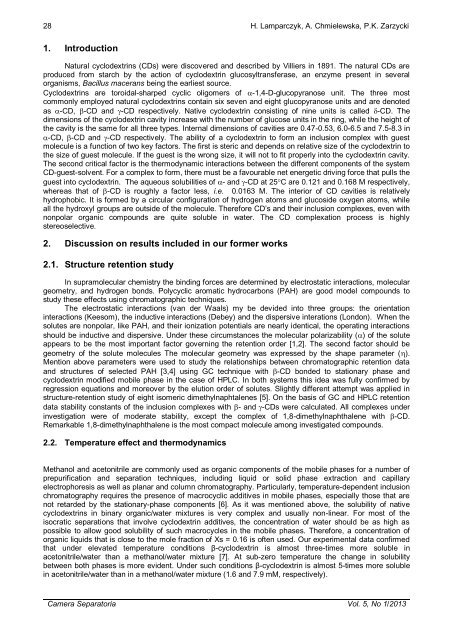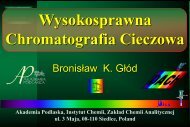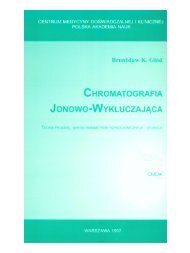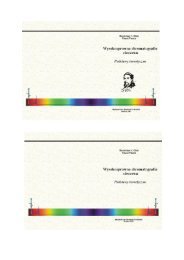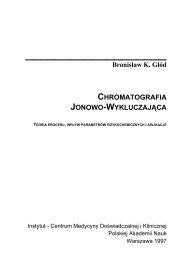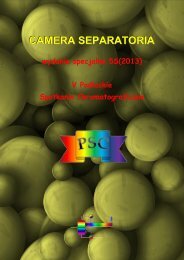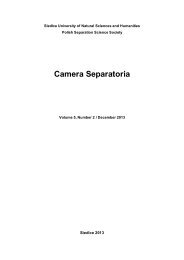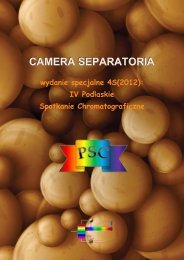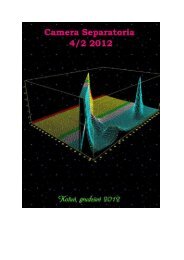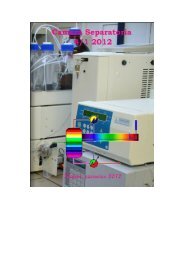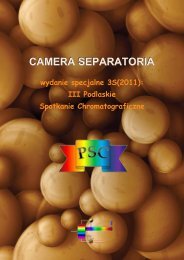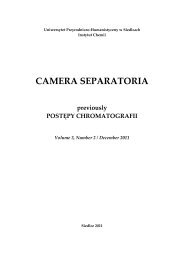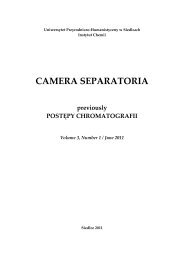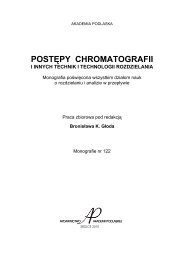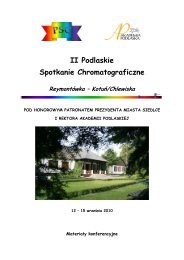CamSep 5 1
Create successful ePaper yourself
Turn your PDF publications into a flip-book with our unique Google optimized e-Paper software.
28 H. Lamparczyk, A. Chmielewska, P.K. Zarzycki<br />
1. Introduction<br />
Natural cyclodextrins (CDs) were discovered and described by Villiers in 1891. The natural CDs are<br />
produced from starch by the action of cyclodextrin glucosyltransferase, an enzyme present in several<br />
organisms, Bacillus macerans being the earliest source.<br />
Cyclodextrins are toroidal-sharped cyclic oligomers of -1,4-D-glucopyranose unit. The three most<br />
commonly employed natural cyclodextrins contain six seven and eight glucopyranose units and are denoted<br />
as -CD, -CD and -CD respectively. Native cyclodextrin consisting of nine units is called -CD. The<br />
dimensions of the cyclodextrin cavity increase with the number of glucose units in the ring, while the height of<br />
the cavity is the same for all three types. Internal dimensions of cavities are 0.47-0.53, 6.0-6.5 and 7.5-8.3 in<br />
-CD, -CD and -CD respectively. The ability of a cyclodextrin to form an inclusion complex with guest<br />
molecule is a function of two key factors. The first is steric and depends on relative size of the cyclodextrin to<br />
the size of guest molecule. If the guest is the wrong size, it will not to fit properly into the cyclodextrin cavity.<br />
The second critical factor is the thermodynamic interactions between the different components of the system<br />
CD-guest-solvent. For a complex to form, there must be a favourable net energetic driving force that pulls the<br />
guest into cyclodextrin. The aqueous solubilities of - and -CD at 25C are 0.121 and 0.168 M respectively,<br />
whereas that of -CD is roughly a factor less, i.e. 0.0163 M. The interior of CD cavities is relatively<br />
hydrophobic. It is formed by a circular configuration of hydrogen atoms and glucoside oxygen atoms, while<br />
all the hydroxyl groups are outside of the molecule. Therefore CD’s and their inclusion complexes, even with<br />
nonpolar organic compounds are quite soluble in water. The CD complexation process is highly<br />
stereoselective.<br />
2. Discussion on results included in our former works<br />
2.1. Structure retention study<br />
In supramolecular chemistry the binding forces are determined by electrostatic interactions, molecular<br />
geometry, and hydrogen bonds. Polycyclic aromatic hydrocarbons (PAH) are good model compounds to<br />
study these effects using chromatographic techniques.<br />
The electrostatic interactions (van der Waals) my be devided into three groups: the orientation<br />
interactions (Keesom), the inductive interactions (Debey) and the dispersive interations (London). When the<br />
solutes are nonpolar, like PAH, and their ionization potentials are nearly identical, the operating interactions<br />
should be inductive and dispersive. Under these circumstances the molecular polarizability () of the solute<br />
appears to be the most important factor governing the retention order [1,2]. The second factor should be<br />
geometry of the solute molecules The molecular geometry was expressed by the shape parameter ().<br />
Mention above parameters were used to study the relationships between chromatographic retention data<br />
and structures of selected PAH [3,4] using GC technique with -CD bonded to stationary phase and<br />
cyclodextrin modified mobile phase in the case of HPLC. In both systems this idea was fully confirmed by<br />
regression equations and moreover by the elution order of solutes. Slightly different attempt was applied in<br />
structure-retention study of eight isomeric dimethylnaphtalenes [5]. On the basis of GC and HPLC retention<br />
data stability constants of the inclusion complexes with - and -CDs were calculated. All complexes under<br />
investigation were of moderate stability, except the complex of 1,8-dimethylnaphthalene with -CD.<br />
Remarkable 1,8-dimethylnaphthalene is the most compact molecule among investigated compounds.<br />
2.2. Temperature effect and thermodynamics<br />
Methanol and acetonitrile are commonly used as organic components of the mobile phases for a number of<br />
prepurification and separation techniques, including liquid or solid phase extraction and capillary<br />
electrophoresis as well as planar and column chromatography. Particularly, temperature-dependent inclusion<br />
chromatography requires the presence of macrocyclic additives in mobile phases, especially those that are<br />
not retarded by the stationary-phase components [6]. As it was mentioned above, the solubility of native<br />
cyclodextrins in binary organic/water mixtures is very complex and usually non-linear. For most of the<br />
isocratic separations that involve cyclodextrin additives, the concentration of water should be as high as<br />
possible to allow good solubility of such macrocycles in the mobile phases. Therefore, a concentration of<br />
organic liquids that is close to the mole fraction of Xs = 0.16 is often used. Our experimental data confirmed<br />
that under elevated temperature conditions β-cyclodextrin is almost three-times more soluble in<br />
acetonitrile/water than a methanol/water mixture [7]. At sub-zero temperature the change in solubility<br />
between both phases is more evident. Under such conditions β-cyclodextrin is almost 5-times more soluble<br />
in acetonitrile/water than in a methanol/water mixture (1.6 and 7.9 mM, respectively).<br />
Camera Separatoria Vol. 5, No 1/2013


